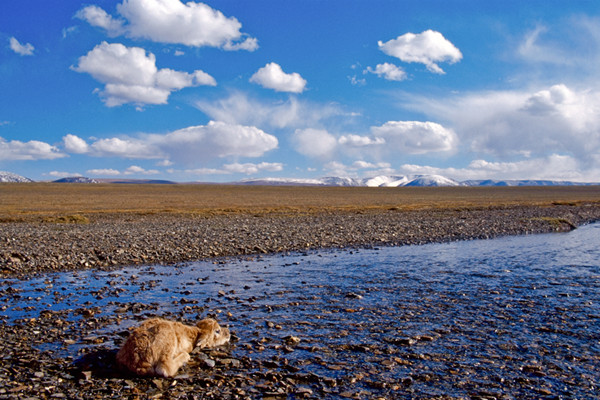Plateau guardians
 0 Comment(s)
0 Comment(s) Print
Print E-mail China Pictorial, September 4, 2013
E-mail China Pictorial, September 4, 2013
Every June and July, upon finishing a long journey from their habitats, tens of thousands of pregnant Tibetan antelopes arrive on the banks of Zonag Lake in central Hoh Xil to give birth. During that period, the kinetic curiosity of newborn antelope calves bouncing around their resting mothers complements the anticipation of soon-to-be moms all elegantly nestled together along the south bank. Atop the plateau, the thunder of hooves serenading epic scenes of majestic herds floating against the mountainous backdrop never fails to take human breath away.
 |
|
Tibetan Antelope (Pantholops hodgsonii), Kekexili, Qinghai, June 2000. [Photo/Xi Zhinong/WildChinaFilm] |
Native to the Qinghai-Tibetan Plateau, the Tibetan antelope is primarily found in the Changtang region of Tibet, Altun Mountains of Xinjiang, and Qinghai Province's Hoh Xil and the source area of the Yangtze, Yellow and Lancang rivers. In the early 1990s, when shahtoosh, a luxurious shawl woven from Tibetan antelope wool, saw high demand in Western countries, illegal hunting and selling of the Tibetan antelope and its fur became more and more rampant, resulting in at least 29,000 antelopes being killed annually. Moreover, intensified poaching, which had severely disturbed the living patterns of Tibetan antelopes, has become a big threat to the species' survival.
| Stories not to miss: |
|
• Wild China |
In 1992, due to insistence by Sonam Dargye, then secretary of Western Working Committee at Zhidoi County Party Committee in Qinghai Province, the "Wild Yak Team" was established with private funds to fight the poaching of Tibetan antelopes. Under the leadership of Sonam, a large team was recruited to join in protecting rare wild animals on the plateau. Sadly, on January 18, 1994, Sonam was shot to death by poachers he had captured. Over the following years, with new members coming from demographics such as veterans, unemployed youth or even former poachers, "Wild Yak," a less-than-70-member anti-poaching team, was working in many regions of Hoh Xil, where a large number of wildlife habitats are found.
Upon Hoh Xil National Nature Reserve Administration's establishment in 1998, more drastic measures were taken to punish poachers of Tibetan antelopes as well as illegal traders of the fur. It was reported that in October 2009, a total of 2,282 pieces of antelope hides, which had been confiscated from poachers since 1999, were destroyed by the administration in the suburb of Golmud in Qinghai Province.






Go to Forum >>0 Comment(s)